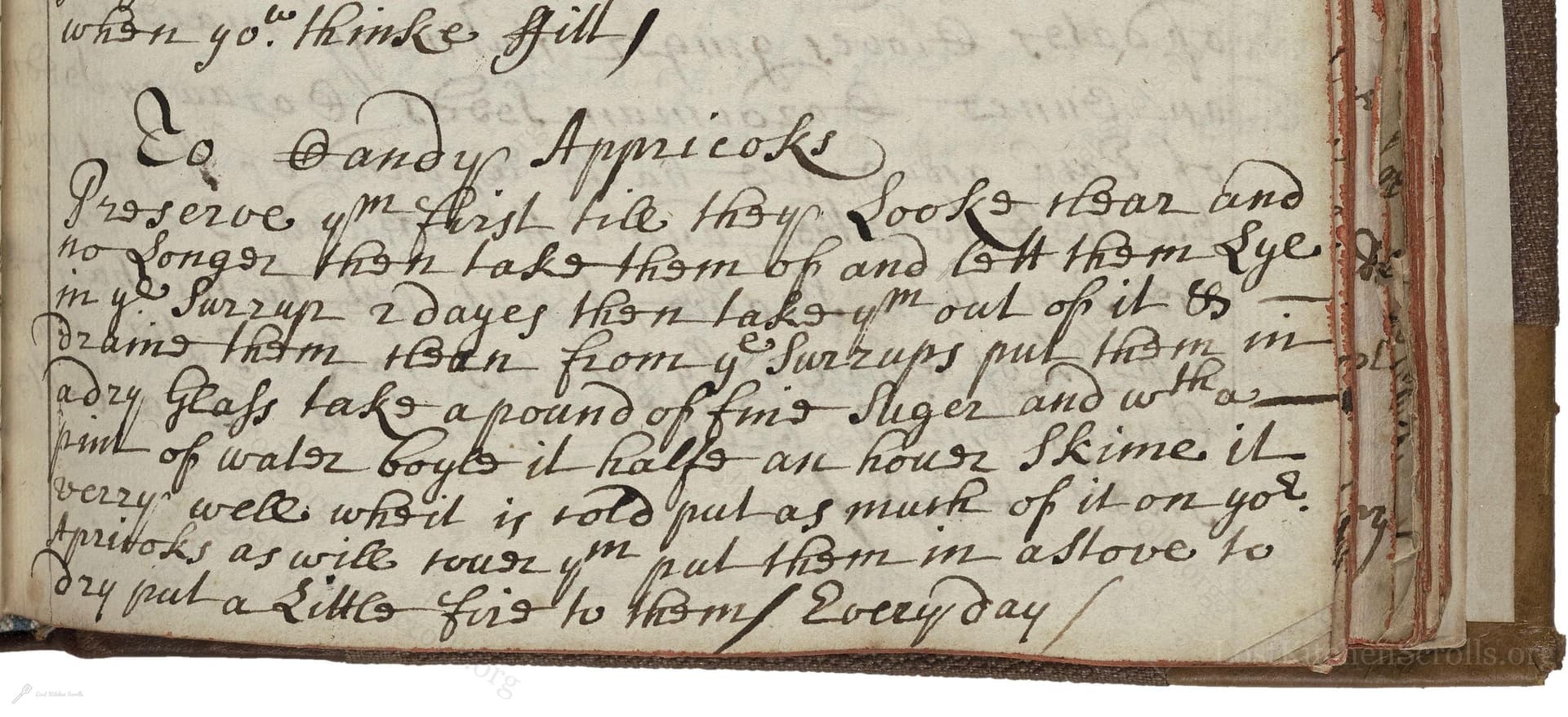To Dandy Appricokes Preserve
From the treasured pages of Cookbook of Constance Hall
Written by Constance Hall

To Dandy Appricokes Preserve
"ym first till they Looke clear and no Longer than take thm out and sett thm bye in ye Surrup 2 dayes then take ym out of it & drane thm then from y! Surrups put thm in a dry Glass take a pound of fine Suger and wth apint of water boyle it halfe an hower Skime it very well when it is cold put as much of it on yo! Apricoks as will Cover ym put thm in a Stove to dry put a little fire to thm Every day/"
Note on the Original Text
The recipe is written in the informal, practical vernacular of its day, without precise measurements, timings, or temperatures. Spellings are inconsistent and often phonetic ('ym' for 'them', 'ye' for 'the', 'boyle' for 'boil'). Instructions are structured as a running narrative, assuming the reader has experience in preserving and access to specialized domestic knowledge. Capitalization is irregular, and punctuation minimal, characteristic of manuscript cookbooks before standardized recipes.

Title
Cookbook of Constance Hall (1672)
You can also click the book image above to peruse the original tome
Writer
Constance Hall
Era
1672
Publisher
Unknown
Background
A spirited foray into 17th-century kitchens, this collection by Constance Hall brims with the flavors, secrets, and delicacies of Restoration-era England—perfect for cooks keen to revive a dash of history in their modern menus.
Kindly made available by
Folger Shakespeare Library
This recipe hails from 1672 and is attributed to Constance Hall, a woman of likely gentle birth, who would have had access to both luxury ingredients like sugar and a domestic staff. 'Dandy' (likely a dialectal or miswritten form of 'candy') refers to the sweet preserving of apricots, a practice associated with high-status kitchens in early modern England. Sugar, a costly imported good, increased the prestige of such preserves, which were both a culinary delight and a display of wealth and refinement. The recipe exemplifies the fashion for preserving fruits for enjoyment well out of season, a practical and pleasurable art in grand households of the 17th century.

In the 17th century, this recipe would have called for large earthenware or copper pans for poaching and boiling, a slotted spoon or ladle for removing the delicate apricots, and glass jars or vessels for storing the preserves. A 'stove' referenced here was likely an enclosed warming cupboard or the low heat of a hearth embers, not an open fire. Maintaining a steady, gentle warmth was key to drying and preserving the sugared fruit.
Prep Time
20 mins
Cook Time
40 mins
Servings
6
We've done our best to adapt this historical recipe for modern kitchens, but some details may still need refinement. We warmly welcome feedback from fellow cooks and culinary historians — your insights support the entire community!
Ingredients
- 1 lb 2 oz fresh apricots (or substitute: firm canned apricots without syrup, drained)
- 1 lb fine white sugar
- 2 cups water
Instructions
- Begin by gently poaching whole apricots (fresh, ideally firm and just ripe, about 1 lb 2 oz) in enough water to cover them, cooking until they appear clear and slightly translucent.
- Remove the apricots carefully and set them aside in their syrup for two days to infuse the sweet flavors.
- After this resting period, take the apricots out and allow them to drain.
- In a clean saucepan, prepare a syrup by boiling 1 lb of fine white sugar with 2 cups of water for 30 minutes, skimming regularly to keep the syrup clear.
- Once the syrup has cooled, pour enough of it over the drained apricots to cover them in a large glass container, ensuring they are fully submerged.
- Place the container in a warm, dry place (such as a low oven or an airing cupboard) for several days, lighting a gentle fire or using low heat each day to help the apricots dry and preserve in the syrup.
- This simulates the drying technique of a 17th-century stove.
Estimated Calories
140 per serving
Cooking Estimates
Preparing these preserved apricots takes time mostly because they rest in syrup for two days and then dry for several more days. Actual hands-on preparation and cooking are much shorter, about an hour total. Each serving is estimated to have 140 calories, and this recipe makes about 6 servings.
As noted above, we have made our best effort to translate and adapt this historical recipe for modern kitchens, taking into account ingredients nowadays, cooking techniques, measurements, and so on. However, historical recipes often contain assumptions that require interpretation.
We'd love for anyone to help improve these adaptations. Community contributions are highly welcome. If you have suggestions, corrections, or cooking tips based on your experience with this recipe, please share them below.
Join the Discussion
Rate This Recipe
Dietary Preference
Main Ingredients

Den Bockfisch In Einer Fleisch Suppen Zu Kochen
This recipe hails from a German manuscript cookbook compiled in 1696, a time whe...

Die Grieß Nudlen Zumachen
This recipe comes from a rather mysterious manuscript cookbook, penned anonymous...

Ein Boudain
This recipe comes from an anonymous German-language manuscript cookbook from 169...

Ein Gesaltzen Citroni
This recipe, dating from 1696, comes from an extensive anonymous German cookbook...
Browse our complete collection of time-honored recipes



